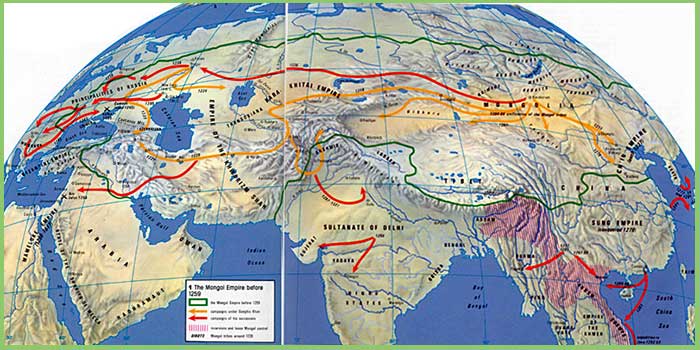Mongolian history - Ancient times:
There are many traces of the ancient human race in the territory of Mongolia, including archaeological discoveries in the white cave of Bayanlig and stone weapons found in the Uran Khairkhan hill of Baatsagaan somon, Bayankhongor aimag. According to these discoveries, it becomes likely that human being lived in the territory of Mongolia almost 700 thousand years ago. There is a hypothesis that Mongolia is a cradle of the very first human race on Earth. This assumption is based on the appearances of Mongols.
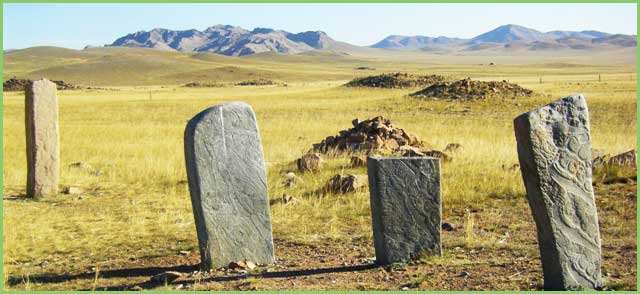
Mongols had straight black hair, broad foreheads, narrow eyes, thick lashes, short noses, protruding cheek bones, strong chests and narrow waists. Those people were the product of nature and climatic conditions of Mongolia. Skilled labor produced the homo sapiens almost 40,000 years ago. With the increase of wealth and emergence of private ownership, the clan structure collapsed. Wealthy families came to live in aimag structures. Several aimags formed a union of aimags. Power was concentrated among few descendants of wealthy families and heads of aimags.
Mongolian Ancient Empires
Hunnu state: (Hsiung-nu, 3rd century BCE - 2nd century CE)
Mongol, Turk and Jurchen races had been living in the Mongolian territory from ancient times. They alternatively ruled over each other. However the first politically organized community was the Hunnu State. It was the prototype of the states of Mongolia. According to the chronicles, there was a nomadic tribe Khu in the 5th century BCE. The people were engaged in animal husbandry and each tribe had its chief cleric.
They formed a confederation of tribes. Those were the Hunnu people who became particularly prosperous in the 4th century BCE. The confederation annexed 24 Hunnu aimags. Tumen was named the Khaan of the Hunnu. Tumen belonged to the aristocratic family of the Khian tribe.
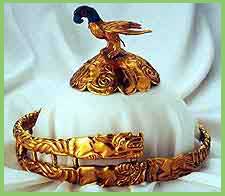
It was since that period that Khaan ceased to be elected at the conference, but became a dynastic title. Hunnu people fell victims of the aggressive policy pursued by the Ching dynasty, and aimed at expanding the territory to the North. The Hunnus were driven far from the Ordos territory. The Chinese fortified their new Great Wall.
Tumen Khaan made unsuccessful attempts to unite various Hun aimags and organize the state. Tumen Khaan, induced by his young wife, made his son by his youngest wife, the heir to the throne. But his elder son Modun, assassinated both his father and his younger sibling and seized the throne in 209 BCE. The Hunnu State was not a merely Mongol State. It was the first organized State among the nomadic people of the Central Asia.
Cianbi state: (Hsiung-pi) (2nd - 4th centuries CE)
The South Hunnu was under a strong Chinese influence and the North Hunnu people moved farther to the North. The remaining 100 thousand families, or over 500 thousand Huns, joined the Cian-bi people, who formed the Cian-bi State. Tanishikhuai (136-181) played an important role in organizing and consolidating the Cian-bi State. The Cian-bi State grew stronger and expanded its territory in the east and occupied the territory stretching as far as to the Korean peninsula.
The Cian-bi State was situated on the territory stretching from the lake of Baikal to the Chinese wall, and from the Korean peninsula to the He Tarbagatai. Tanishikhuai divided his State into 3 parts: eastern, central and western. In 181 СЕ Tanishikhuai passed away and his son Khelyang took over. The State affairs deteriorated under his rule. The Cian-bi State broke up.
However, Kebinen, lord of one of the aimags, gathered over 10 thousand soldiers and reunited the Cian-bi State. In 235 СЕ Kebinen died. As a result, in the middle of the 3rd century CE, after his death, the Cian-bi State was divided into the East and West Cian-bi States, and gradually collapsed.
Jujan state (Rouran):
The Jujan State is related to the Cian-bi people. Those were Mongolian speaking people. The State stretched on a vast territory of Mongolia, the western part of Manchuria and eastern part of the Uighur autonomous region, in the present Sing-zian. In the 5th century CE in the territory of the Jujan State there was the lake of Baikal in the North, Gobi and Chinese wall in the South, the Altai mountain range in the West and Korean peninsula in the East. The political center of the Jujan State was located at the foot of the Khangai Mountain.
Tureg State (580-745 CE):
The policy of Tureg (Turkic) State was aimed at taking control over the great trade road. By 580's CE, Tureg State expanded to annex numerous aimags with people of diverse nationalities. They defeated the Ephtalit State in the West and subdued the Kirghiz people living in the Enisei basin of Siberia in the North. During the period of Tureg State its territory expanded to reach the Korean peninsula.
By the end of 4th century CE, the Turkic State was divided into the eastern and western parts. And Uighur people, who were a part of the Turkic State, defeated the eastern Turkic State in 745 CE. Thus the Uighur State became the successor of the Turkic State.
Uighur State: (745- aprox 900 CE)
The Uighur State adopted and pursued on the policy of the Tureg State. During this period the Uighur State controlled the great trade road from China to the Middle East.
Kidan State (10th-12th Centuries)
Between the 10th-12th centuries, the Kidans (Mongol origin) took over. They lived in the basin of the Liao River at the eastern foothills of the Khyangan Mountains. The Elui tribe ruled the Kitan State. In 901 Ambagyan of the Elui tribe ascended the throne. The Kitan State occupied the southeast of the Mongolian territory in 924, Bahain and 16 regions in the North of China in 936. However, intertribal discords and feuds undermined the strength of the Kitan State. At the end of 1120's, the Kitan State collapsed and later succeeded by the Mongols.
Genghis Khan and the Largest Empire in World History
Founder and ruler of the
Mongol Empire in the 13th century, Mongolians consider
Genghis Khan the father of modern Mongolia. While historical records written by non-Mongolians express different views, Mongolians recognize his positive role in their history. They give him credit for the introduction of
the traditional Mongolian script, the first written Mongolian law, religious tolerance, his great military leadership and for bringing the Silk Road under one cohesive political umbrella, an accomplishment which allowed increased communication and trade between Europe, the Middle East and Asia.
Today, his name and image can be found on everyday commodities from liquors to Mongolian currency to a hillside portrait in Ulaanbaatar-the capital of Mongolia
and Genghis Khan statues have been erected throughout the country, among which a 40 meter tall equestrian statue, the tallest in the world.
Forming the Mongol Empire (13th Century):
The moment when then Mongolians made themselves known to the world. War has been explained in many different ways in the course of history. The saying that “the strong conquers the weak” has not yet lost its meaning, and even nowadays this principle is still in force. However, every possible reason has been brought forth to justify war. The 13th century was only one moment in the history of humankind. War was then means to determine ideas. Even today, ideas are sometimes determined by force. The 13th century was in fact a historic opportunity for the Mongolians to make their ideas known to and accepted by others.
Temujin became the Khaan of All Mongols, and the title
"Chinggis Khaan" was conferred upon him. By 1205, All Mongol Khanates had been subjugated by Chinggis Khaan. At the Huraltai (Assembly of Mongol States), held in 1206, it was proclaimed that the peoples of Mongolian ancestry had been united. Chinggis Khaan ascended the throne of the united Mongol States to become the Great Mongol Emperor.
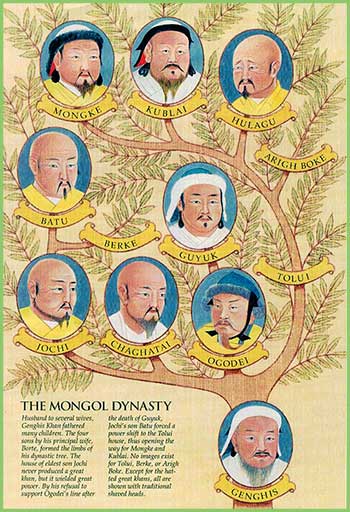
Mongolia between the 14th to 16th centuries
The Mongol Empire declined at the end of the 14th century. Nevertheless, the Mongol Empire remained in the form of confederation. It controlled the territory stretching from the Khyangan Mountains in the East, up to the Irtish and Enisei rivers, from Tengri Mountain in the North, the Great Wall of China in the South.
The last Emperor of the Mongol Dynasty was Togugan Timor. In the early 15th century, Mongolia was divided into two separate parts, which led to further breakup of the Empire. Dayan Khaan (1464-1543) ascended the throne in 1470. His efforts aimed at reunification of All the Mongols had failed.
Mongolia from 17th to the 19th centuries:
The period that started from the end of the 15th century and lasted for nearly 3 centuries, can be referred to as era of the Manchu domination in Asia. The Manchu was a highly militaristic State that attacked and subjugated Mongolia. Ligden, the great grandson of Batu-Mongke Dayan Khaan, who was the last direct descendant of Chinggis Khaan, was defeated. After having conquered the Tsahar State in 1636, Manchus took Inner Mongolia under their control. In 1644 Beijing was occupied.
Mongolia was divided, and the
Khalkha Mongols and Oiryid Mongols waged wars against each other. At the meeting initiated by Undurgegen Zanabazar, feudals representing the Inner Mongolia and Outer Mongolia took a decision to seek protection of the Manchu State. Thus, Mongolia came under the full control of Manchus.
The Ching Dynasty established its rule and laws over the entire territory of Mongolia. The Manchus consistently pursued on the policy aimed at maintaining disunity of Mongol aimags. Numerous attempts to throw off the Manchu yoke were undertaken by Mongols. The last unsuccessful uprising in 1755-1758, was led by the Oiryid Mongolian Prince Amarsanaa. The Manchu tyranny was to last up to the 20th century.
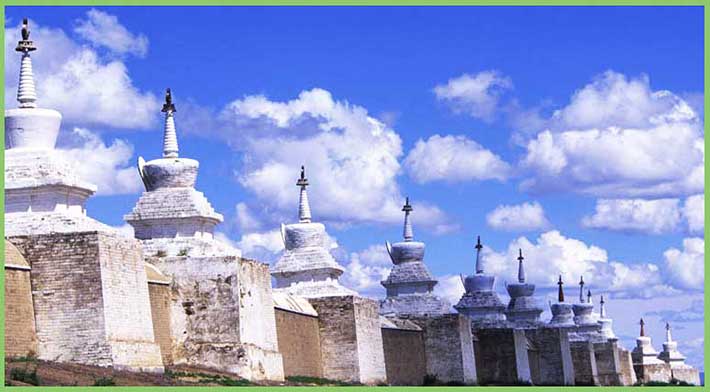
Mongolia: (Early 1900s)
Theocratic state: After many attempts to restore independence of Mongolia had failed, Mongolians, desperate to throw off the Manchus, appealed to Russia for aid. In 1911, a meeting was convened in Ikhe Khuree (present Ulaanbaatar), at which the 8th Bogd, the Head of Religion and noble men from the Inner Mongolia decided to send a delegation to Russia.
However, the mission was unsuccessful. In November of 1911, the 8th Bogd, urged to declare independence of Mongolia and provisional government was formed. The provisional government was headed by G.Chagdarjav, speaker of Tusheet Khan Aimag, and consisted of seven members, including Prince Ts. Khanddorj and G. Tserenchimed, the high lama. The govemmnet led the national liberation movement. By the end of 1911, the Manchu viceroy in Jikhe Khuree was forced out, in the early 1912, Uliastai, another important administrative post, was liberated. Liberation of the western part of Mongolia in the summer of 1912, created conditions for the overthrow of the Manchu rule in the whole territory of Mongolia.
Bogda Javjandamba became a monarch, and declared independence of Mongolia. In the South, the Manchus were defeated by the Chinese. The Chinese Republic, established in 1912, was headed by president da Juntan Yan-Shi-Kai. It refused to recognize Mongolia's independence. In 1914, three-party talks to include delegations from Mongolia, Russia and China, were launched. These talks, known as Khyagta meeting, dealt with the political status of Mongolia. As a result of these talks, a tripartite agreement was reached, according to which Mongolia was split up, to form Outer Mongolia and Inner Mongolia but remained independent.
Revolutionary Events (1919-1921)
Russia's revolution of 1917 had a great impact on events in Mongolia. Russian Czarist General G. Semenov initiated a conference, at which the formation of pan-Mongolia confederation was declared. The confederation was to consist of Inner and Outer Mongolia, Barga and Buryat Mongolia. Mongolian government was not represented at this conference.
Nevertheless, Chinese military troops, headed by General Hsu-Shi-Chang, were deployed in Jikhe Khuree. Mongolia's autonomy was abolished in November, 1919. Revolutionary events in Russia inspired spontaneous uprisings in Mongolia. Two underground political groups were formed, which in June of 1920 were organized into the People's Party of Mongolia.
One of the leaders of the liberation movement - D.Sukhbaatar - formed the people's army of Mongolia and liberated Jikhe Khuree from Baron Ungern, in July 1921. By 1922, the entire territory of Mongolia was free from foreign occupation, and the people's government was formed.
Political Repression (1924-1939)
In 1920s, after the death of the
Bogd Khaan, Mongolia had a real alternative to repressions and executions, that followed the revolutionary events. The idea of development along the path of national democracy was extremely popular among many leaders of the Mongolian People's Party (MPP) and government. However, the influence on the part of Komintern and Bolshevik government in Russia was overwhelming.
In August of 1924, the third Congress of the MPP adopted a communist type program, thus condemning the country to many years of political terrorism and later on stagnation and political inertia. The first Deputy Prime Minister S. Danzan and others, who stood in opposition to the majority's views, were executed. This marked the beginning of witch hunting in Mongolia.
Many prominent leaders, including the Prime Minister B. Tserendorj, Deputy Prime Minister A. Amar, Chairman of the MPP's Central Committee, and T. Tseveen fell victims to Stalinist type repressions. Repressions against religion and lamas were especially severe. Between 1937-1939, over 700 temples and monasteries were destroyed,' and over 17,000 lamas and monks executed. Political massacre continued up to 1941.
Mongolia during World War II
In 1930s, when fascism in Europe and Asia became a real threat, Mongolia signed a Protocol with the Soviet Union, on rendering military assistance in case of insult by a third country. Undeclared war started on 28 May 1939, when Japanese troops attacked Mongolia's borders in the area of the Khakhyn-Gol. Pursuant to the provisions of the Protocol, Soviet troops were brought up to the border, and Mongolian-Soviet joint forces stopped the invader in August, 1939. The tripartite negotiations held between Mongolia, Soviet Union and Japan in 1940, settled the border disputes.
When in June 1941 the Nazist Germany invaded the Soviet Union, Mongolia offered a helping hand to the Soviet people. Domestic resources were mobilized and sent as aid to the Soviet Red Army. At the Yalta conference held in February, 1945, the leaders of the Soviet Union, USA and UK agreed to the existing status quo with regards to the Outer Mongolia.
Socialism under the Soviet Union
After the World War II, Mongolia adopted the Soviet five-year-plan pattern in the economic policy. In 1958, 99.7 percent of the country's total livestock was nationalized. In 1960, the Constitution was revised to proclaim a single political party monopoly, single form of property and communist ideology.
Mongolia remained one of the most closed countries in the world up until 1990s. Politically, the country was a satellite of the Soviet system. Economically, Mongolia was heavily dependent on Russian subsidies. Distortions in the economy and inefficient governance brought the country to social, economic and political stagnation.



